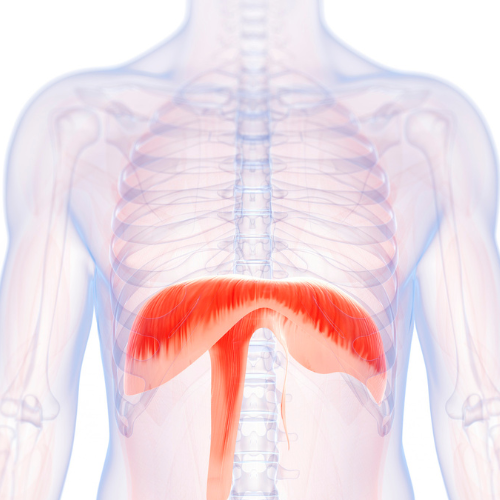In this final installment of our 5-part Breathe Easy series, we take a look at one of the most effortless, but fundamental ways to calm your nervous system.
What is Belly Breathing?
Also known as diaphragmatic breathing, Belly Breathing is a technique that involves using your diaphragm effectively to draw air deep into your lungs. Instead of shallow chest breathing, you expand your belly as you inhale and contract it as you exhale.
 The diaphragm is a dome-shaped muscle located beneath the lungs, separating the chest cavity from the abdominal cavity. It plays a crucial role in breathing by contracting and relaxing, to expand the lungs and draw in air.
The diaphragm is a dome-shaped muscle located beneath the lungs, separating the chest cavity from the abdominal cavity. It plays a crucial role in breathing by contracting and relaxing, to expand the lungs and draw in air.
How to Do It
- Find a comfy spot: Sit or lie down comfortably, with your back straight but relaxed. Make a conscious effort to release any tension in your shoulders and unclench your jaw.
- Place one hand on your chest and the other on your belly: This helps you feel the movement.
- Inhale slowly through your nose: Let your belly expand like a balloon as you breathe in. Feel your hand on your belly rise and notice the sensation of the air travelling through your nose.
- Exhale slowly through your mouth: Contract your belly gently as you exhale, feeling your hand sink down and note how it feels to empty out your lungs.
- Repeat: Find a comfortable rhythm that works for you and keep breathing in this way for a few minutes, focusing on the rise and fall of your belly.
Why It Works
- Calms the mind: Belly Breathing triggers the body’s relaxation response, reducing stress and anxiety.
- Boosts oxygen flow: Deep breaths send oxygen-rich blood throughout your body, energizing you.
- Enhances focus: By centering your attention on your breath, you cultivate mindfulness and improve concentration.
How to Teach Belly Breathing to Kids
- Make it fun: Use visual aids like balloons or bubbles to demonstrate belly expansion and contraction.
- Storytime: Invent a playful story where they’re filling a balloon with air (inhale) and then slowly letting the air out (exhale).
- Use props: Have them lie down with a stuffed animal on their belly. As they breathe in, make the animal rise; as they breathe out, let it sink.
- Lead by example: Practice Belly Breathing together as a family. Kids learn best by seeing and doing.
- Remember: Consistency is key. Encourage your kids to practice Belly Breathing for just a few minutes each day. It’s a valuable skill they’ll carry with them for life.
As simple as Belly Breathing is, having someone guide you through this exercise can make all the difference. Close your eyes and just follow the voice in the video below as it leads you into a state of calm and relaxation:
Why so many breathing exercises with the same goal?
Because there’s no one-size-fits-all approach. Individuals may find that one technique resonates more with their physiology and preferences than another. It also prevents benefits from becoming stagnant because our bodies tend to adapt to repetitive stimuli over time, which can lead to diminishing returns on the benefits of the exercise.
Our 5-part series on breathing techniques has now equipped you with a versatile array of tools to enhance your well-being and manage stress. From the structured rhythm of Box Breathing to the calming cadence of 478 Breathing, the tactile approach of 5 Finger Breathing, and the fluidity of Figure 8 Breathing and Belly Breathing (this post), cultivate mindfulness, help reduce anxiety, and achieve a deeper sense of inner peace by always remembering to Breathe Easy.
